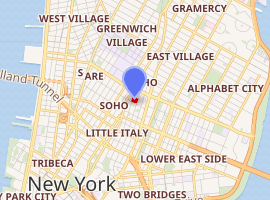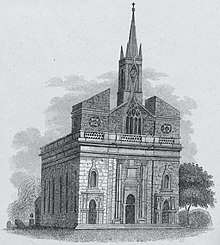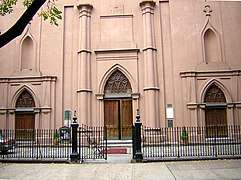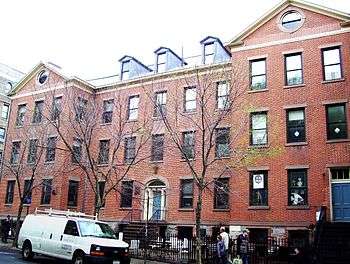St. Patrick's Old Cathedral
The Basilica of Saint Patrick's Old Cathedral, or Old St. Patrick's, is located at 260–264 Mulberry Street between Prince and Houston streets in the Nolita neighborhood of Manhattan, New York City, with the primary entrance currently located on Mott Street. Built between 1809 and 1815, and designed by Joseph-François Mangin in the Gothic Revival style,[2] it was the seat of the Roman Catholic Archdiocese of New York until the current Saint Patrick's Cathedral opened in 1879.[3][4] Liturgies are celebrated in English, Spanish, and Chinese.
| St. Patrick's Old Cathedral | |
|---|---|
Mulberry Street facade | |

| |
| Location | Mulberry Street, Manhattan, New York City |
| Country | United States |
| Denomination | Roman Catholic |
| Tradition | Latin Rite |
| Website | St. Patrick's Old Cathedral |
| History | |
| Status | Minor basilica, former cathedral |
| Dedication | May 14, 1815 |
| Architecture | |
| Architect(s) | Joseph-François Mangin |
| Style | Gothic Revival |
| Groundbreaking | 1809 |
| Completed | 1815 |
| Administration | |
| Archdiocese | Archdiocese of New York |
Old St. Patrick's Cathedral Complex | |
 Location in New York City  St. Patrick's Old Cathedral (New York)  St. Patrick's Old Cathedral (the United States) | |
| Coordinates | 40°43′24.9″N 73°59′43.1″W |
| Area | 1.8 acres (0.73 ha) |
| NRHP reference No. | 77000964[1] |
| NYCL No. | 0187 |
| Significant dates | |
| Added to NRHP | August 29, 1977 |
| Designated NYCL | June 21, 1966 |
The church was designated a New York City landmark in 1966,[5] and the cathedral complex was added to the National Register of Historic Places in 1977.[1] It was declared a minor basilica by Pope Benedict XVI on Saint Patrick's Day, March 17, 2010.
History

The first Roman Catholic church in New York City was St. Peter's on Barclay Street, the cornerstone of which was laid in 1785.[6] By the early 19th century, the Jesuit rector of that church, Anthony Kohlmann, realized that the city's growing Catholic population needed both a second sanctuary and a cathedral for the first bishop, since the city had been made a see in 1808.[7] The site he selected for the new church was being used as a cemetery for St. Peter's,[2] and was well outside the settled area of the city, surrounded by farmland and the country houses of the rich.[7] The architect chosen was Joseph-Francois Mangin, who had co-designed New York's City Hall with John McComb Jr.,[8] construction on which was ongoing when the cornerstone of St. Patrick's was laid on June 8, 1809. Construction took just under five years, with the sanctuary being dedicated on May 14, 1815. In that same year, John Connolly, an Irish Dominican friar, arrived to take office as the city's first resident bishop. The church, which was the largest in the city at the time it was built, now measures 120 by 80 feet and the inner vault is 85 feet high (37m x 24m x 26m).
Until 1830 the cathedral was the ending place of New York's annual St. Patrick's Day parade. After that, it ended further south along Mott Street at the Church of the Transfiguration, whose pastor, Felix Varela, was a Spanish political refugee from Cuba. In New York, he served as the chaplain of the Hibernian Universal Benevolent Society.[2][9] Eventually, the parade moved uptown to pass in front of the new St. Patrick's Cathedral (1879).
In 1836, the original cathedral was the subject of an attempted sack after tensions between Irish Catholics and anti-Catholic Know-Nothing nativists led to a number of riots and other physical confrontations. The situation worsened when a brain-injured young woman, Maria Monk, wrote a book telling her "true" story – a Protestant girl who converted to Catholicism, and was then allegedly forced by nuns to have sex with priests, with the resulting children being baptized then killed horribly. Despite the book being debunked by a mildly anti-Catholic magazine editor, nativist anger at the story resulted in a decision to attack the cathedral.[9] Loopholes were cut in the church's outer walls, which had just recently been built, and the building was defended from the rioters with muskets.[2][9] Afterwards, the Ancient Order of Hibernians established its headquarters across the street from the church. Thirty years later, in 1866, the cathedral was gutted by a fire that spread from a nearby shop, and even though the new St. Patrick's was already under construction, the old cathedral was restored under the direction of architect Henry Engelbert and reopened in 1868.[10]
Since 1879, St. Patrick's Old Cathedral has been a parish church, the pastor residing in the old Bishop's House at 263 Mulberry Street. Today's multi-ethnic parish includes the territory of the former Most Holy Crucifix Parish, whose church for a time was the nearby Chapel of San Lorenzo Ruiz and housed the Filipino Catholic Apostolate for the Archdiocese of New York.
Cathedral complex
St. Patrick's Old Cathedral School at 32 Prince Street, across from the Cathedral, predates the church itself. It was built in 1825–1826 as the Roman Catholic Orphan Asylum, operated by the Sisters of Charity. In 1851, the asylum became for girls only, and in 1886 became St. Patrick's Convent and Girls School, before turning co-educational again. The Federal-style building is a New York City landmark, designated in 1966.[11] The school finally closed in 2010 as enrollment dwindled, and the building was converted into residential and office space.[12]
In 1859, a "Gingerbread Gothic"[2] Chancery Office Building was built at 266 Mulberry Street, just north of the sanctuary, designed by James Renwick Jr. and William Rodrigue, who would go on to design the new cathedral.[5] The building would later become St. Michael's Chapel[2] and, since 1936, St. Michael's Russian Catholic Church of the Byzantine Rite;[13] the liturgy is said and sung in Old Church Slavonic, Russian, and English. St. Michael's is the last Russian Catholic church in New York City and one of only four remaining such sanctuaries in the United States.[14]
Underneath the basilica are catacombs which currently consist of 35 family crypts and 5 clerical vaults, and which have reopened to new interments. The basilica has also opened the catacombs to walking tours led by "Tommy's New York".[15] Among the notable interments are the first resident Bishop of New York John Connolly, General Thomas Eckert, several members of the Delmonico restaurant family, Countess Annie Leary, and Congressman John Kelly.[16] In addition, two New Yorkers who are currently on the road to sainthood, Pierre Toussaint and Father Isaac Hecker, were originally interred there before being moved; Toussaint to the new St. Patrick's Cathedral, and Hecker to St. Paul the Apostle Church. The founding mother superior of New York's first Sisters of Mercy convent, Mary Agnes O'Connor, is also buried there.[17]
Old St. Patrick's Cathedral gallery holds a large pipe organ that was built in 1868 by Henry Erben, originally operated without any use of electricity. After the new cathedral opened uptown in 1879, the Erben organ was left downtown with minimal alterations. In 2004, the Organ Historical Society designated it as an instrument of "exceptional historical merit, worthy of preservation", the organ equivalent of national landmark status. The instrument remains in use for Sunday services while awaiting further restoration.[18][19]
 Mulberry Street entrance
Mulberry Street entrance Mott Street entrance
Mott Street entrance Interior
Interior Former Chancery
Former Chancery Cemetery
Cemetery Former School
Former School
In popular culture
- The baptism scene in The Godfather was filmed in the old Cathedral, as was the scene in The Godfather Part III in which Michael Corleone receives an honor from the church.
- The cathedral's walled graveyard was the setting for a scene in the film Mean Streets directed by Martin Scorsese, a former altar server at the cathedral.[20]
- The underground mortuary vaults of the old Cathedral were featured on the Secrets of New York episode "Deep NY - How Low Can You Go in the Big Apple", on NYC Media.
See also
- List of Catholic cathedrals in the United States
- List of cathedrals in the United States
- Philadelphia Nativist Riots
References
- "National Register Information System". National Register of Historic Places. National Park Service. March 13, 2009.
- Dunlap, David W. (2004). From Abyssinian to Zion: A Guide to Manhattan's Houses of Worship. New York: Columbia University Press. ISBN 0-231-12543-7., p. 236
- Betty J. Ezequelle (March 1977). "National Register of Historic Places Registration: Old St. Patrick's Cathedral Complex". New York State Office of Parks, Recreation and Historic Preservation. Archived from the original on 2012-10-09. Retrieved 2009-10-31. See also: "Accompanying 11 photos". Archived from the original on 2012-10-09.
- Remigius Lafort, S.T.D., Censor, The Catholic Church in the United States of America: Undertaken to Celebrate the Golden Jubilee of His Holiness, Pope Pius X. Volume 3: The Province of Baltimore and the Province of New York, Section 1: Comprising the Archdiocese of New York and the Diocese of Brooklyn, Buffalo and Ogdensburg Together with some Supplementary Articles on Religious Communities of Women. New York City: The Catholic Editing Company, 1914, pp. 303–307.
- NYCLPC, p. 43
- Brown, Mary Elizabeth and Osborne, Ernest L. "St. Peter's Church [Roman Catholic]" in Jackson, Kenneth T., ed. (2010). The Encyclopedia of New York City (2nd ed.). New Haven: Yale University Press. ISBN 978-0-300-11465-2., p. 1142
- Burrows & Wallace, pp. 480–481
- NYCLPC, p. 28
- Burrows & Wallace, pp. 543–546
- Mendelsohn, Joyce; Garrity, James E. "History". Saint Patrick's Old Cathedral. Retrieved December 4, 2019.
- NYCLPC, p. 42
- Kaysennov, Ronda (November 8, 2015). "Luxury Condos in a Former NoLIta Orphanage". The New York Times.
- Stmichaelruscath.org
- Stmichaelruscath.org
- http://www.ny1.com/nyc/all-boroughs/news/2017/07/31/saint-patrick-s-old-cathedral-opens-its-centuries-old-catacombs-to-the-public.html
- https://ny.curbed.com/2016/8/22/12583592/soho-st-patricks-old-cathedral-crypt-for-sale
- Lunney, Sheila (2009). "O'Connor, Mary". Dictionary of Irish Biography - Cambridge University Press. Retrieved 2020-03-29.
- Whitney, Craig R. (October 26, 2004). "Arts, Briefly: Organ Donors Sought". The New York Times.
- "Basilica of St. Patrick's Old Cathedral". American Guild of Organists.
- Lyman, Rick (February 13, 1998). "In Little Italy With Martin Scorsese". The New York Times.
Bibliography
- Burrows, Edwin G. & Wallace, Mike (1999). Gotham: A History of New York City to 1898. New York: Oxford University Press. ISBN 0-195-11634-8.
- New York City Landmarks Preservation Commission; Dolkart, Andrew S.; Postal, Matthew A. (2009). Postal, Matthew A. (ed.). Guide to New York City Landmarks (4th ed.). New York: John Wiley & Sons. ISBN 978-0-470-28963-1.
External links
| Wikimedia Commons has media related to St. Patrick's Old Cathedral. |


